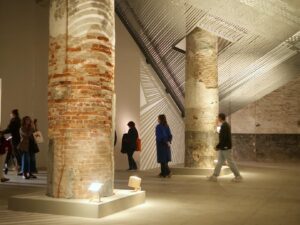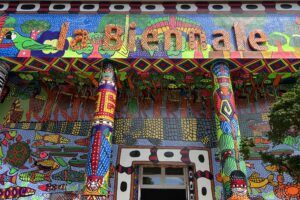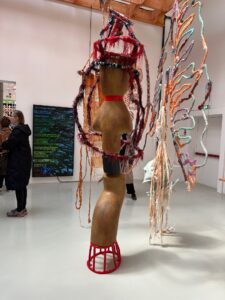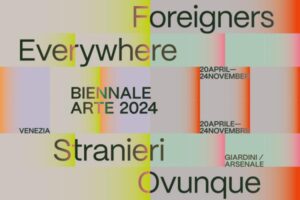Nancy Nesvet

The Publisher of the Art Lantern recently told me, “All you need for a good story is to write about something you love.” The Venice Biennale is that. Encompassing the world, political only in its regard for addressing issues that make the world a better and more environmentally sustainable place for all of us, the Venice Biennale celebrates and brings together those who hail from all over the world, showing exhibits that marry history, geography, the arts, environmentalism, anthropology. In a concerned but ultimately optimistic creative response to current problems and issues, the Biennale challenges our current and past world, informing about history, corroborating history attained by means other than written records, and challenging false narratives, historical, political and anthropological. With eighty-eight national participations in pavilions owned by nations represented with an embassy in Italy, and official collateral exhibitions chosen by Adriano Pedrosa, this year’s visual arts Curator of the Biennale Arte, Foreigners Everywhere, with additional exhibits and performances mounted by global arts groups outside the purview of the official biennale, the sixtieth Biennale is a world of creativity lasting six months. The Art Lantern’s five writers and editors, from different nations on different continents were there for the opening days of this Biennale, covering as many exhibits as possible, which we include in this issue.
In projects throughout the Biennale, visitors are forced to confront foreign languages and vocabularies, ways of expressing thought and documenting relations and other important issues and facts of societies not our own. We are urged to realize that the arts, music, performance, words of the bards, making of textiles, organization of the lands, flora and fauna, rock carvings, myth are languages used to transmit knowledge, history, and culture. At the Pavilion of Saudi Arabia, women appropriate dances and songs usually performed by men, asserting their voices and desires, proclaiming themselves. The German theatre and opera director Ersan Mondtag creates theatre, based on the migration of his grandfather from Turkey to Germany in the 1960’s. Adriano Pedrosa’s choices of projects justifiably address gay culture and the culture of the physically and mentally challenged, the unrecognized, the incarcerated as these societies have developed a distinct language through which cultures are transmitted. Pedroso has recognized artists as historians and anthropologists, linguists, documentarians and makers of culture and societies.
Enthralled by the knowledge, customs, traditions, and art of indigenous and “Other” people displayed, I felt uneasy, looking from the outside at experiences and exhibitions created so I, a westerner may better appreciate and understand “their” cultures. I am the foreigner, and there were “Foreigners Everywhere” like me. Explanatory texts were in Romance languages, Italian and English, privileging those from formerly imperialist cultures. Why, I wondered, was I not forced to observe in the language of the indigenous, the vision challenged? The Biennale read like a history book written in a western language, with an unavoidably westernized view, for a westernized audience to understand what it observed and partook in. I would rather be without a map or text in English to follow the exhibition, feeling like those who encounter a western culture not their own. Only in this way may we become a true “Family of Man – and Women” with equal challenges and understanding of visual and auditory symbols and of each other. Since visual art is visual language, perhaps additional language text beyond that of the indigenous culture sponsoring the exhibition is unnecessary, as images and codes of visual culture are capable of communicating. Perhaps this speaks to the power of art to communicate without nation-centered words.

Video by Yael Bartana
The winner of the Golden Lion was Archie Moore, with his installation, Kith and Kin. With Australia’s walls of a vast room covered with names of indigenous people resident there, all from the family of the artist, it overwhelmed with the number. Some were redacted, and there were blank spaces, where some could not be accounted for, Yet the names on the wall were in phonetic English characters, a colonialist language. I would argue that reliance should be on visual codes and images, an indigenous written language, that reference the names of family members over millennia. That is what art is capable of: creating the visual codes and symbols of an international language, understandable by all. If done well, as it was at several exhibits, explanations in English and Italian were unnecessary. If the explanation was necessary, artists and curators have often not done well enough with their visual art production. Archie Moore, of the aboriginal Kamilaroi and Bigambul First Nation of what is now known as Australia in presenting Kith and Kin, deservedly winning the National Pavilion Golden Lion for his exhibit at the Australian Pavilion brilliantly introduced Adriano Pedrosa’s curatorial thesis, defining artmaking as the cross-cultural language that disseminates information about ancient, indigenous cultures worldwide. Writing with white chalk on blackboard painted walls and ceiling, in a giant dark cave like space, he created a vast family tree documenting his Aboriginal Bigambul genealogical family, his kith and kin over the last 65,000 years, adding his Scottish family from their 1800’s arrival after the 1788 British colonial takeover of what is now Australia, creating an anthropological diagram of a kinship system. As Aboriginal Bigambul nations did not have written records, Moore relied on oral history, myth, rock carvings and other visual and audial information for documentation of relations and his genealogical history. With Aborigines in Arnhem about 60,000 years ago and in Kakadu, evidenced by rock shelters, and rock paintings in Kimberley, 32,000 years ago, engravings in Cape York, 30,000 years ago, discovery of remnants of funerary rights at Cape Mungo attesting to aboriginal presence 60,000 years ago, Moore was able to trace his genealogical aboriginal roots since the Dream Time, Creation, at least 60,000 years ago. Kamilaroi and Bigambul text, expressed in phonetic characters, of names, nicknames, adopted geographical names where no surname is available, positions, and other identifying information link people, places and times on the walls and ceiling, forming a non-linear family tree of 2400 generations of Archie Moore’s family. Both branches have redacted names, positions, and geographical names, respecting privacy, and when unknown. Blanks appear when information is missing or has been destroyed. A reflective pool of black-appearing water serving as a memorial for First Nation Australians who died in state custody underlies a table of stacks of white paper; bureaucratic documents. Variegated in height, appearing like architectural models of modern-day buildings holding bureaucratic documents, the stacks of white paper form a square installation, on which were printed names of those incarcerated and murdered by the colonialist authorities. It underscores the criminality the British imposed on their colonists, opposed to the familial survival of aboriginal people and cultures, and those transported from Britain.

Similarly, the winner of the Golden Lion for the Curator’s exhibit at the Arsenale, The Mataaho Collective, a group of Maori women installed a large room size, fiber-based installation illustrating Maori lived and knowledge systems, emphasizing Maori women’s collective power. The product of a decade of work by the collective, the long threads of industrial and natural fibres spanning the ceiling and forming tents, using traditional Maori art techniques, are reflected on the floor as shadows. This vast, encompassing installation, from floor to ceiling of fiber art proclaims art and cooperation producing shelter and beauty.
Foreigners were everywhere, crowds and long lines challenged time allowed to see many exhibits. Acknowledging that we are all foreigners in Venice, a historic crossroads of people from Asia and the European continent, Adriano Pedrosa and the curators of National Pavilions have mounted exhibits that highlight the contributions and history of indigenous people worldwide. Although the history often illustrates sordid and violent actions of conquistadores and imperialist regimes, exhibitions including the Spanish pavilion admits this history of conquest, serving as a confessional. Acknowledging the conquerors as the foreigners, this Biennale treats those conquests challenging the indigenous culture, but showing indigenous peoples’ continuing ties to their land and traditions, retaining age-old customs and traditions that force us to acknowledge vast contributions of indigenous people to the wellness and arts of western-derived society, past and present. Although ignored to a degree by colonialist, imperialist societies, indigenous people carried on, never lost traditions, medicinal cures, and arts, and now show to the world all that they have retained. At the Pavilion of Brazil, we learn that Ka’a Puera or capoeira fields that seem dormant after the harvest rather host vast swarths of sacred and medicinal plants as well as the Ka’a Puera, a bird that camouflages itself in the undergrowth. Queer people have developed a culture that is here shared, so it is no longer strange, as do the cultures of physically and sensory challenged people.
For me, this is the essence of this Biennale. Whereas the last Biennale drew from a book that showed how humans might change and encompass all changed forms, this Biennale celebrates all that has not changed, a world that includes all indigenous populations and all foreigners everywhere, in all the lands on this planet that we call ours. Rather than looking toward who we might become, this Biennale looks at what and who we are, and begs us to see each other. We look to Adriano Pedrosa’s native South America for the generosity of indigenous people in the Global South to travel to Venice, once a crossroads of culture and commerce, to share their cultures, traditions and knowledge, a generous act for a world that did not often extend generosity to those who do so now. Although conquerors and imperialists tried to quash native culture, here those who practice native arts and culture proudly share with others so foreigners may engage with “Other” cultures.
Adriano Pedrosa focuses on the language of textiles, often used by indigenous peoples and those from the Global South, and to blood kinship of several artists in the show, carrying on family bloodlines, uniting all of us as the human family deriving from the same creation or dreamtime, traditions and vocations assigned to progeny that carry on through the ages. Pedrosa focuses on the indigenous, the marginalized, the different, the queer, who contribute to a changing society by carrying on age-old traditions and inventing new ones, and who, sharing their traditions and history become visible to foreigners in Venice. Perhaps this show is ultimately about visibility, and inclusion of all, old and new cultures, and traditions, evolving and staid. I would suggest a better title for the show, “The Family of Man (and Woman)” because that is what it is about; all people on this planet, their histories, geographies, politics, bodies, arts, and abilities, or perhaps we should call it, Metamorphosis, where one is transformed upon encountering the Other.
In several pavilions given over to indigenous people, I wanted communication in their own language, not understandable to me, to initiative that feeling of uncertainty as to what was happening, how to react. I wanted to understand their art, but to gradually inform myself by close observation and instruction, with those who created it, leading me, not putting up an exhibit where they were not present. I wanted those who created the work to explain it, using image or gesture, teaching me the language, making me part of their world.

Foreigners Everywhere is optimistic, full of bright color, partially due to Pedrosa’s and curators of national pavilion’s emphasis on textiles, the art of indigenous peoples. We are greeted by a 700 square foot, colorful mural on the façade of the Arsenale’s Central Pavilion entrance to the Biennale, by the indigenous Amazonian art collective, MAHKU, (Movimento dos Artistas Huni Kuin) depicting hallucinatory visions inspired by sacred rituals of the Ayahuasca. Nowhere is there explanatory text, and that is good.
The US pavilion, presenting the space in which to place me by Jeffrey Gibson, a Native American Choctaw and Cherokee Artist, not only had brightly colored, geometrically patterned hand-painted paintings inspired by Native American textile patterns but featured an ongoing performance; Native American dance and music throughout the day by indigenous peoples of the land that is now the USA. The observers became participants, sitting on the concrete steps behind and with the dancers, dancing along, seeking to learn the steps and understand the meaning and culture of the dance and the paintings. An outdoor sculpture and group of classic pedestals turned the forecourt into a gathering place where visitors and performers sat and talked, watching the performances. Gibson’s evoking of ancestral spirits, embodied by towering figures with ceramic heads included the sculpture, “We Want to Be Free” referring to the Indian Citizenship Act of 1924, granting indigenous people basic rights and the 1866 Civil Rights Act that guaranteed citizens equal protection under the law. The “Enforcer” sculpture references the Reconstruction Acts that protected the rights of Black citizens and the Enforcement Act of 1870, prohibiting interference with a citizen’s right to vote. Using found beads, Gibson’s multimedia work glorifies Native American matriarchy, costumes and arts practices.
The Pluri-National State of Bolivia’s pavilion presents work that encourages us to see the experience of walking and carrying, looking behind and in front of us, so introducing a progression that is not linear, but rather melds the future with the past, of the present land with the ancestral land, proclaiming the land living.
There were, fittingly for Venice, a city on water, with canals leading into the open sea, several exhibits concerned with water. The France Pavilion, featured the work of French-Caribbean artist Julien Creuzet incorporatating poetry, music, assemblage, cinema and animation to evoke imagery of future relics swept back to the land by ocean tides, referring perhaps, to his own story of venturing out to the sea from his birthplace, Martinique, to settle in France but returning, and always keeping in his mind and heart, Martinique. The catalogue speaks of the writings of Edouard Glissant, “of the inescapability from and magnetic relationship with one’s surroundings…the starting point for a way of thinking about the world”. The catalogue produced by Julien Creuzet includes previously unpublished works by Creuzet and abstracts from literary texts shared among people from the African diaspora. Seventy sound pieces, constituting a sonic reader, in French, English, Spanish and Portuguese shared on Instagram and utube give voice to its authors, hailing from and uniting people from many nations and territories in the Francophone and formerly colonial world. Here, the four languages used are all languages of the Caribbean, Creuzet’s birthplace and France, his future home. All belong to the artist and his history as text, flowing between languages and from one language to another, joining water as an overriding motif of exhibitions at the Biennale that trace the flow of people.
At the Mexican Pavilion, Mexican artist Erick Meyerberg, of Lebanese and German descent, explores the migrant’s construction of identity as a foreigner, documenting the Doda family’s experiences and memories of exile from Albania to Italy, adding the perspective of the exiled to that of migrant or voyager, exploring the emotional aspects of the foreigner, with music and food sustaining them and their connection to Albanian culture.
Adriano Pedrosa has done a commendable job as Curator of this 60th Venice Biennale. He has provided the opportunity to indigenous artists to open a window onto their cultures and histories and arts, making foreigners aware of the incredible contributions to the world of indigenous and gay and challenged artists.
I would be remiss not to mention the closed pavilion of Israel, where the artist chose to not to give access to her work inside objecting to the current Israel-Hamas War, choosing not to open the exhibit until a ceasefire. It was possible to see the exhibit through plate glass windows. The Biennale and the art world affords artists the platform to show their views. By silencing oneself, artists negate the opportunity to express themselves as has been done here. Art Lantern encourages artists to express their views through their artmaking and writers to air criticism without fear or favor.

